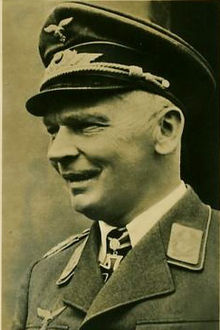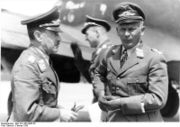Wolfram Freiherr von Richthofen
| Wolfram von Richthofen | |
|---|---|
| 10 October 1895 – 12 July 1945 (aged 49) | |
 Generalfeldmarschall Wolfram von Richthofen |
|
| Place of birth | Barzdorf, near Striegau, Germany |
| Place of death | Bad Ischl, Austria |
| Allegiance | |
| Years of service | 1913-1920, 1923-1944 |
| Rank | Generalfeldmarschall |
| Unit | Jasta 11 |
| Commands held | Condor Legion, VIII. Fliegerkorps, Luftflotte 2, Luftflotte 4 |
| Battles/wars | |
| Awards | Ritterkreuz mit Eichenlaub |
Generalfeldmarschall Wolfram Freiherr von Richthofen[Notes 1] (10 October 1895 Barzdorf – 12 July 1945) was a German Field Marshal General of the Luftwaffe during World War II.
Von Richthofen was fourth cousin of the German World War I flying ace Manfred von Richthofen, popularly known as the "Red Baron," and the baron's younger brother Lothar von Richthofen.
Contents |
Early life and World War I
He was born on the Barzdorf estate, near Striegau, Lower Silesia. During World War I he served in a German cavalry unit. In 1918 he learned to fly fighter aircraft and was transferred to the predecessor to the Luftwaffe, the Luftstreitkräfte. In March 1918 he was assigned to Jasta 11 fighter squadron.[1] He scored his first aerial victory on 4 June 1918, and by the end of the war he became a flying ace, having shot down seven enemy fighter planes, as well as an Airco DH.4 bomber.[2]
Von Richthofen studied aeronautical engineering from 1919 to 1922 at the Technical University of Hanover. On 18 September 1920, he married Jutta von Selchow (1896–1991) at Breslau (now the city of Wrocław in Poland). The couple had three children.
Moreover, Wolfram von Richthofen had served in Rome in 1929-1931 as an "informal" air attache in violation of the disarmament clauses of the Versailles Treaty.[3]
Condor Legion
In 1933 von Richthofen joined the Luftwaffe. He was initially in charge of developing and testing new aircraft and was deployed to the Condor Legion in the Spanish Civil War in 1936 to monitor new aircraft in combat. He became Chief of Staff to Hugo Sperrle in 1937 and later its commanding officer, during which period the Condor Legion bombed the Basque town of Guernica, with great loss of civilian life, an action that became a worldwide symbol of the horrors of aerial bombing. According to some sources (Nicholas Rankin) it was Von Richthoven himself who selected the mix of blast, splinter and fire bombs for this particular operation. German sources blame Italian bombers for the destruction of the town. He was heavily involved in drawing lessons from the Civil War that would serve the Luftwaffe well in World War II. In September 1938 he was promoted to Generalmajor and served as an advisor to General Francisco Franco until he returned to Germany in May 1939 to assume command of the now returned Condor Legion.
Opponents of the Stuka
Von Richthofen was one of the foremost opponents of the Stuka concept. He called for the suspension of all further Ju 87 development (believing instead in the development of heavy strategic bombers). However Ernst Udet immediately rejected von Richthofen's instructions and Ju 87 development continued. Von Richthofen was Chief of Staff of the Legion Condor and as three Ju 87As were transferred to Spain and began to show what they could do, his long-standing skepticism of dive bombers gradually changed to admiration.
World War II
At the outbreak of World War II on 1 September 1939 von Richthofen commanded VIII. Fliegerkorps during the Invasion of Poland.[Notes 2] He directed the attempt to destroy Warsaw from the air.
During the Battle of France from 10 May 1940 the Junkers Ju 87 dive bombers of VIII. Fliegerkorps supported Walther von Reichenau and his Sixth Army in Belgium and Paul von Kleist's Panzergruppe von Kleist in France. During the Battle of Britain von Richthofen's unit took part in the unsuccessful attempt to subdue the Royal Air Force.
In April VIII. Fliegerkorps were tasked with supporting the Battle of Greece and the Battle of Crete. Following the successful conclusion of this campaign von Richthofen, now a General, became the 26th recipient of the Knight's Cross of the Iron Cross with Oakleaves (Ritterkreuz mit Eichenlaub) on July 17, 1941. Following the Balkans campaign, von Richthofen was appointed commander of Luftflotte 2,[Notes 2] based in Italy.
Barbarossa

On 22 June 1941 Germany launched Operation Barbarossa, the invasion of the Soviet Union. Richthofen had refined the close support tactics and ground liaison methods that he had developed since the Spanish Civil war, and his air corps provided critical support for the army's Moscow offensive (Operation Typhoon) and the subsequent desperate defensive actions after the Soviet counter-offensive. He was promoted to generaloberst in February 1942, thereby holding the same rank as air fleet commanders and the highest Luftwaffe staff officers (Jeschonnek and the late Udet). In May/June 1942, VIII. Fliegerkorps also played an important role in Erich von Manstein's successful campaign in the Crimea and the capture of Sevastopol. Richthofen worked closely with Manstein during the campaign and each held the other in the highest professional regard. Manstein later described Richthofen as "certainly the most outstanding air force leader we had in World War II."[4]
At the end of June 1942, Richthofen was appointed commander of Luftflotte 4, which supported Army Group South in its advances towards the Stalingrad and Caucasus regions. In the winter of 1942 the Sixth Army under Friedrich Paulus were surrounded by a Russian counter-attack during the Battle of Stalingrad. Hitler was assured by Field Marshal Hermann Göring that the Luftwaffe could supply the Sixth Army by air, and as a result, Hitler denied the request of Paulus to retreat from the city. Wolfram von Richthofen tried in vain to overturn this decision to try to supply the entire German Sixth Army by air. Although the air bridge did manage to deliver over 8,300 tons of supplies during a 72 day period, this was much too little for the besieged army. The operation cost Luftflotte 4 nearly 500 aircraft and 1,000 crewmen.
After the failure of the air-bridge, and the failed Operation Wintergewitter to relieve the city, Hitler promoted Paulus to field marshal in his besieged Stalingrad headquarters in an effort to convince his commander to commit suicide rather than surrender. When Paulus surrendered anyway on 31 January 1943, Hitler declared, "That is the last field marshal I make in this war!"[5]
However on 16 February 1943, only two weeks later, Hitler promoted von Richthofen to the rank of Generalfeldmarschall, he became one of only six officers in the Luftwaffe in the history of the Third Reich to be promoted to this rank (The others were Hermann Göring, who had held the rank from 1938 until his promotion to Reichsmarschall in July 1940, Albert Kesselring, Erhard Milch, Hugo Sperrle, and when the Third Reich was within days of falling, Robert Ritter von Greim). Von Richthofen was 47 at the time and the second-youngest person to be promoted to the rank of field marshal in Nazi Germany, after Hermann Göring (who was promoted when he was 45). Von Richthofen was retired on medical grounds in late 1944. He subsequently died of a brain tumor whilst being held in American captivity at Bad Ischl on July 12, 1945.
Promotions
- Fähnrich - 22 March 1913
- Leutnant - 19 June 1914
- Temporary Oberleutnant - 29 February 1920
- Rejoined the Army with rank of Leutnant - 1 November 1923
- Oberleutnant - 31 July 1925
- Hauptmann - 1 February 1929
- Major - 1 June 1934
- Oberstleutnant - 20 April 1936
- Oberst - 23 January 1938
- Generalmajor - 1 November 1938
- General der Flieger - 19 July 1940
- Generaloberst - 1 February 1942
- Generalfeldmarschall - 16 February 1943
Notes
References
- Citations
- ↑ Norman L. R.; Bailey, Frank W.; Guest, Russell. "Above The Lines: A Complete Listing of the Fighter Aces of the German Air Service, Naval Air Service and Flanders Marine Corps, 1914-1918." Grub Street, London, United Kingdom, 1993 (1998 edition)
- ↑ http://www.theaerodrome.com/aces/germany/richthofen3.php Retrieved on 5 August 2010.
- ↑ Whealey 1989, p. 48.
- ↑ Hayward 1998, p. 73.
- ↑ Fest 2002, p. 665.
- Bibliography
- Fest, Joachim C. (2002). Hitler. New York, New York: Mariner Books. pp. 856. ISBN 978-0156027540.
- Hayward, Joel S.A. (1998). Stopped at Stalingrad: The Luftwaffe and Hitler's Defeat in the East, 1942-1943. Lawrence: University Press of Kansas. ISBN 978-070061146-1.
- Obermaier, Ernst (1976). Die Ritterkreuzträger der Luftwaffe 1939-1945 Band II Stuka- und Schlachtflieger (in German). Mainz, Germany: Verlag Dieter Hoffmann. ISBN 3-87341-021-4.
- Scherzer, Veit (2007). Die Ritterkreuzträger 1939–1945 Die Inhaber des Ritterkreuzes des Eisernen Kreuzes 1939 von Heer, Luftwaffe, Kriegsmarine, Waffen-SS, Volkssturm sowie mit Deutschland verbündeter Streitkräfte nach den Unterlagen des Bundesarchives (in German). Jena, Germany: Scherzers Miltaer-Verlag. ISBN 978-3-938845-17-2.
- Whealey, Robert H. (1989). Hitler and Spain: The Nazi Role in the Spanish Civil War, 1936-1939. Lexington, KY, University Press of Kentucky.
- Helden der Wehrmacht - Unsterbliche deutsche Soldaten (in German). München, Germany: FZ-Verlag GmbH, 2004. ISBN 3-924309-53-1.
External links
- Wolfram Richthofen : Nazi Germany at www.spartacus.schoolnet.co.uk
- Electronic Encyclopaedia of Civil Defense and Emergency Management at www.richmond.edu
See also
- The Red Baron (film), which has a fictionalized version of Wolfram von Richthofen
| Military offices | ||
|---|---|---|
| Preceded by none |
Commander of VIII. Fliegerkorps 19 July 1939 – 30 June 1942 |
Succeeded by General der Flieger Martin Fiebig |
| Preceded by Generaloberst Alexander Löhr |
Commander of Luftflotte 4 20 July 1942 – 4 September 1943 |
Succeeded by Generaloberst Otto Deßloch |
| Preceded by Generalfeldmarschall Albert Kesselring |
Commander of Luftflotte 2 11 June 1943 – 27 September 1944 |
Succeeded by disbanded |
|
||||||||||||||||||||||||||||||||||
|
||||||||
|
|||||||||||||||
|
|||||